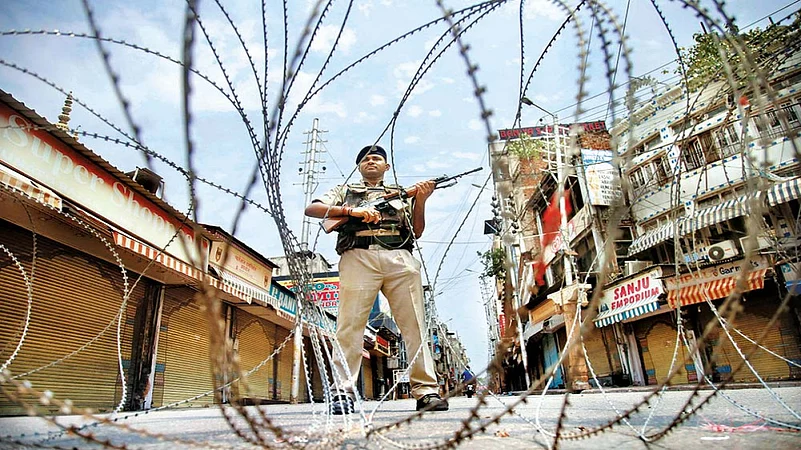Spring is when Kashmir’s full palette of colours comes to life. White almond, pink cherry blossoms, the yellow of mustard, multi-coloured, state-manicured tulips…after a hibernating, sullen, stark winter, the gates open upon myriad smells, and it’s all colour and bloom. Sitting under an almond tree in full blossom at the badamwari (almond orchard) with the sharp sting of sunrays on your face, you tend to forget the bleakness of winters. Hope is renewed and you thank yourself or your creator (whatever may be your calling) for having endured the long winter. Of course, this is a fictional depiction! The reality is that, in Kashmir, the flowers of spring wilt and fade even before summer can visit. An army check-post on the boulevard intrudes into your tranquil walk along the Dal. Winter announces itself back in the middle of spring. Head bowed, you take a solitary walk back home.
This is not the story of only one spring—the spring of 2020. For almost three decades, this is how every spring…or for that matter every season…has passed in the Valley, shackled in concertina, moored in the longing for the flowers and breeze of spring. But this year, spring was strangely different. For the first time, we were indoors because of something beyond human control. Covid did not deign to spare the already-suffering. This was the spring when the world bore some resemblance to Kashmir. Human misery itself became a pandemic, everyone came to know what a lockdown feels like—a struggle of the spirit to not shut down, to endure. Amidst all the abstract dread and anxiety that stalked the world, The Plague, a 1947 novel by French Algerian writer-philosopher Albert Camus, amassed new readership. From Japan, Italy to Great Britain, people seemed to be asking the dead author questions about life—held in suspension. A simple Google search in mid-year threw up some 100 articles written between January and April 2020 on the book and the lessons one can draw from it.
ALSO READ: Our Wronged Rights
I read the novel for the first time in 2011, perhaps because of fashion and fascination with someone deemed an ‘outsider’ and a ‘rebel’ among the Parisian intellectuals of his generation. The second time was in October 2019, amidst one of the recurring lockdowns of Kashmir—‘curfew’ for us. I completed a third reading while most of the world was under lockdown because of Covid, waiting for the curve to somehow flatten. Camus always wrote within a certain setting and, as Tony Judt says in the introduction to The Plague, “Camus put something of himself—his emotions, his memories and his sense of place—into all his published work…” So, it is only reasonable that I read Camus’s book with the place—and the situation—in which I am/was reading him.
Everyone knows the story: the erstwhile princely state, Dogra rule, the decolonisation of South Asia and Partition, the local prince’s ambivalence and eventual accession to India under unusual circumstances, the unmet promise of referendum, Article 370, three wars, self-determination movement, denial and manipulation, armed resistance…. Those of us born in the 1980s grew up in that last, seemingly endless phase: protests, killings, rapes, curfews and lockdowns were our vocabulary of the ‘normal’. Forcible disappearances (nearly 8,000), torture, sexual assault and rape were wielded as weapons of war against the people. People died suddenly all the time, as if there was a pandemic in the air—70,000 of them in three decades. Why should we not count mental illness, one of the gifts of the State? A report by Doctors Without Borders (MSF) suggests, “Nearly 1.8 million adults (45% of the population) in the Valley show symptoms of significant mental distress.” A mini-pandemic by itself....

ALSO READ: In Our Roots Are Our Rights
Then came August 5, the day in 2019 when even that canvas was darkened further. Forget autonomy. History, geography, culture, language and, yes, land...everything became stake as the gods of New Delhi rolled the dice. And the castle gates clanged down. Immediate curfew. Individual movement all but frozen, to remain so for months. Our lockdown began then—except there was no internet or phone link. No YouTube videos on Dalgona coffee. No Facebook commiserations. Not even that speed dial to your dear ones. It was at this moment, one of almost pristine, tomb-like silence, that I picked up The Plague. Camus, I felt, was speaking directly to me. “...a quiet individual feeling such as being separated from a loved one suddenly became, in the very first weeks, the feeling of a whole people,” he wrote, “the greatest agony of that long period of exile.” The period from August till October definitely felt like an exile. I could not talk to close friends, relatives and, for the time I was away from home, to my old and ailing parents whom I talk to almost every day.

Tired and miserable about everything, on October 21, 2019, my little diary read, “What happens when you live in a plague? Unlike Camus’s novel, this is not an actual plague, but rather a human-induced separation, closure and exile. A situation where everything has stopped—communication, mobility, minds...and it seems our hearts as well. I wonder how people will love and live anymore.” Imagine a situation where you have to walk some 20 km, begging policemen and offering all sorts of excuses, only to make a call of a few minutes to your loved ones. “Fire stations and police stations with working phone lines have become like new temples and mosques where people dutifully go to offer their respects. To even think what this uncertainty is doing to the individual and collective psyche....” And then, “I wonder how people think of the future, when they know it does not exist. How do they love? Probably ‘how’ is a wrong word. Can they love anymore?” I ended the entry with a question, a gesture, at the absent reader.... “Does the world even think of us—caged like animals—about our life and future?”
ALSO READ: Of Rage, Courage And Democracy
We have no data, only stories to show how people lived under that lockdown. My mother who is diabetic and has over the years developed both diabetic neuropathy and diabetic nephropathy suffered facial palsy in those months. When I saw her, after the curfew had eased a bit, she tried to smile and suggest it was nothing. A doctor friend settled in the US, who was visiting home around that time, mentioned stress.
For too long, Indian civil society and its avowed secularists have remained aloof to the violence growing in their midst. A fringe, never to become the mainstream, they thought. Their real or feigned blindness to the shrinking space for dialogue and dissent first brought a right-wing Hindu party to power and eventually poisoned the whole Indian nation. How well Camus wrote about this blindness, “A pestilence does not have human dimensions, so people tell themselves that it is unreal, that it is a bad dream which will end. But it does not always end, and from one bad dream to the next, it is people who end, humanists first of all because they have not prepared themselves.” And then they are unprepared to deal with the unreality when violence stalks Delhi itself, in broad daylight, for two full days, as state and media roll a wall-to-wall red carpet for President Trump. But just like Camus’s plague bacteria, this virus of violence cannot be contained without actively fighting it.
ALSO READ: Tiger, Tiger Whining Bright!
For over three decades, 700,000 Indian soldiers have been stationed at all times in Jammu and Kashmir—one soldier for every 17 civilians, a good stab at being the world’s most heavily militarised zone. The impact it has on minds and bodies is beyond imagination. Indians either stay blissfully unaware, or prefer a criminal silence. It has happened before, elsewhere. The Northeast tasted AFSPA and state terror much before it reached Kashmir. Dalits, Adivasi populations, and the religious, ethnic and sexual minorities of India have for long seen the violent face of the State rather than its much-feted democracy. The Emergency, 1984, 2002, all those were seen as aberrations, momentary ‘eruptions’, rather than as the tacit norm. Indians kept singing praises of their liberal Constitution, instead of looking at how that document was enacted in the lives of those who stood at the margins of the nation-state. The amateur existentialist in me would say the majority of Indians were more concerned about what the situation ought to be than what it was. They have been busy naming the problem—in linguistic gymnastics—rather than fighting it. Dr Rieux, one of Camus’s protagonists, faced with a similar conundrum of naming the disease, is in no hurry to name it. “You’re asking the wrong question,” he says. “It is not a matter of vocabulary, but a matter of time.”
The Covid lockdown had a terrifying tale attached to it. It came like a diagnostic report: the sickness was now out in the open. The elite and middle classes, ensconsed in their air-purified indoors, lulled by religious-mythic soap operas, or transported to ecstasy beating pots on the balcony, as untold millions of working-class poor walked hundreds of miles in the summer sun...the sheer lunacy of it! Hunger killed them in a country that builds space-ships. The megacities they built, they could not call them their own. India had nothing for them. How will a continuous lockdown impact the economy, asked columnists in well-meaning tones. Did they know the local economy of Kashmir suffered losses of $1.4 billion from August to December, 2019? Indian academicians fret about the shifting of their classrooms from the real to the virtual world. Not a baseless worry. But I am here thinking of teachers across Jammu and Kashmir who, in some parts, did not see their students for over four months and others for over seven months. What about those students? What about their futures, their dreams?
ALSO READ: Nailed To The Cross, Ripe For Rescue
For The Plague to make sense, we need to expand the horizon from which Camus was speaking to us. If we limit this novel to the lessons of ‘living under a pandemic’, we will miss the larger point and limit Camus to something too immediate. No fancy word like post-ideology or post-truth can mask the bare fact that the pandemic has fully exposed the faultlines of our world. From the US, to Italy, China and India, the appalling condition of public health systems, the absence of medical insurance, the permanent crisis of contractual and migrant labour lay open like a wound. Is it not surprising that while big and powerful nations like the US, Britain and India struggled, a small nation like Cuba sent medical missions to help Italy and other countries? It’s not a simple debate about choosing between socialism and capitalism, nor about suggesting Cuba as the best and only example, more a question of where our priorities are and should be. From Corbyn to Sanders, we mocked and ridiculed people who talked about healthcare, ecology and minimum wages for being orthodox and dogmatic. Maybe it’s time we bring back the debates around our everyday issues and reinstate the basic question of justice, welfare and human dignity.
Camus can make sense only when we are ready to see all of us as carriers of potential plague bacilli. Justice calls for an everyday battle, till eternity. Most of the time we might fail, but that is no reason to give up the struggle. As Camus would say, “You have to be mad, blind or a coward to resign yourself to plague.” Unlike Paneloux, the priest in his novel, the aridity of life does not condemn Camus to despair, but rather to freedom and joy. Joy is felt by Sisyphus, Camus’s mythical hero, “for his scorn of gods, his hatred of death, and his passion for life”. The struggle for justice is a Sisyphean effort, that “body straining to raise the huge stone, to roll it and push it up the slope a hundred times over…” and then watching the stone “rush down in a few moments towards the lower world whence he will have to push it up again towards the summit”.
ALSO READ: Floydian Slip
The shadow of World War I, the Great Depression, the Nazi occupation...the existentialist generation of Sartre, Beauvoir and Camus had that grim epoch shaping their modes of thinking. Yet, like many of us, their life was also occupied by cafés, love, friends and work. War is what changed everything for them. Suddenly a world that was so familiar ceased to be familiar anymore. Not only the world, ‘existence’ itself could no more be a certainty. Sartre, who was a prisoner of war for nine months, wrote later that his “own skin was the boundary of space he had”. India had its own holocaust with the Partition violence. “All that a man could win in the game of plague and life was knowledge and memory,” says Camus. But we tend to forget. We like to get consumed by the everydayness of life and relegate questions of oppression, justice and freedom of the ‘self’ in some obscure corner of our brain. Camus did warn us that “the plague bacillus never dies or vanishes entirely, that it can remain dormant for dozens of years…and that perhaps a day will come when, for the instruction or misfortune of mankind, the plague will rouse its rats and send them to die in some well-contended city.” Is this that dark hour? Even if it be, we must choose almond blossoms over gunpowder, living over dying. We must place ourselves on the side of the victims, every time—even in desperate times, we must not forget love. For a world without love is a “dead world”, and the long solitudes of 2020 have given everyone occasion to “grow tired of prisons...and yearn for the face of another human being and the wondering, affectionate heart”. Fighting for love is our only hope in these dark, dark times.
(Views expressed are personal.)
ALSO READ:
Amit Kumar teaches history at Azim Premji University






















